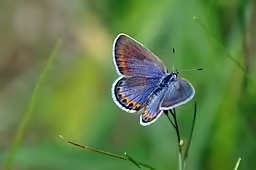Table of Contents for Lupine (Lupinus perennis)
Lupine (Lupinus perennis) is a herbaceous perennial that grows in places that have been disturbed by fire or grazed by animals. Since there has been fire suppression and there are not as many grazers in the forest, the habitat for this plant has been declining. Lupine is a host for eight species of butterflies, including one that is rare and feeds exclusively on it and a nectar source for many others that use the variably colored flowers in the spring. This plant can be purchased in the McMullen House Bed & Breakfast Garden Shop.
Taxonomy and History of Lupine (Lupinus perennis)

Taxonomy
Lupine (Lupinus perennis) was originally described by Carl Von Linnaeus in 1753 in Species Plantarum. Two subspecies are recognized, and include ssp. gracilis, which is found in the southern United States and ssp. perennis that is found in the northeastern United States. This plant is a member of the Legume Family (Fabaceae).
Description and Alternative Names

Description
Lupine is a herbaceous perennial that grows up 1 to 3 feet tall. The alternate, compound, obovate, entire leaflets range from 2 inches in length and about 1 inch in width. This species is sometimes confused with the blue-pod lupine (Lupinus polyphyllus) a western United States species, that is often planted in gardens as lupine and has larger leaflets up to 5 inches in length.
Alternative Names
This plant is also known as Sundial Lupine, wild lupine, Indian beet, or old maid’s bonnets.
Range and Habitat

Range
This species is found from Texas to the eastern United States, but is split between the southern subspecies, gracilis, and the northern, perennis.
Habitat
This plant is found in places that have nutrient poor soils and/or disturbed by fire or grazing. Generally these include fields and roadsides. It can tolerate full sun to partial shade.


Host Species
This plant is a host to the Gray hairstreak (Strymon melinus), clouded sulphur (Colias philodice), silvery blue (Glaucopsyche lygdamus), wild indigo duskywing (Erynnis baptisiae), eastern Persius duskywing (Erynnis persius), frosted elfin (Callophrys irus), and especially the Karner blue (Plebejus melissa samuelis). The Karner blue is a rare butterfly. The rarity is closely correlated to the rarity of the lupine.
Other Wildlife Value
The flowers are used as a nectar source by other butterflies, bees, and insects and the seeds by birds and mammals.
Interesting Facts
The genus name, Lupinus, means comes from the genus name for “wolf” (Lady Bird Johnson Wildflower Center).
Good to Know
When purchasing this plant, make sure that you are getting the right species – (Lupinus perennis) and not blue-pod lupine (Lupinus polyphyllus), unless you are located on the west coast of the United States. The western species will have leaves that are more than twice as long as the eastern species.